Angus. Finewool. Berkshire. Hereford. Southdown. Landrace. These are just some of the livestock show breed classifications 4-H and FFA members might come across as they learn about producing food and fiber while exhibiting animals.
On top of learning about animal husbandry, livestock selection, health, and care, breeds and classifications will come up once you hit the show ring. Unlike registered livestock, which are verified through parentage, papers, and sometimes DNA verification, commercial market animals are typically sorted by visual characteristics into groups for marketing.
Similarly, “club” livestock are sorted into breed classes by visual characteristics. This can mean that while one or many breeds may play out in your animal’s genetic line, it will ultimately be their physical (or phenotypical) characteristics that will sort them into a group of peers.
There are generally a few easily distinguished visual factors that qualify and/or disqualify an animal for a specific breed classification.
As 4-H and FFA members pursue livestock shows at the county, state, or even national level, it can be helpful to select livestock that fit your desired show’s breed classification and to know where your animals will likely get sorted. These classifications are also helpful for livestock judgers and those who participate in livestock skill-a-thons.
While crossbred classes allow a myriad of breed characteristics, exhibiting animals in a breed class is often a source of pride for exhibitors who are interested in a particular breed’s heritage and characteristics.
Classifying cattle at livestock shows
British type classes
Angus
Just like (most of) their registered counterparts, cattle that are classified as Angus need to be solid black (don’t plan on trying to exhibit a red Angus unless your show has a class for reds), polled, tight-sheathed, with moderate ears set high on the head.
Some typical characteristics that might get you placed in a crossbred or other breed class would be coarse joints, horns or scurs, white hair, pink skin, dehorning scars, large sheaths, non-Angus typical ear set, or sheaths.
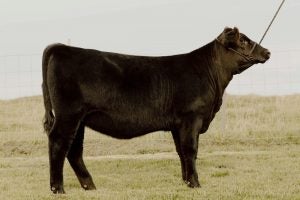
Hereford
Dependent on your show, Herefords may be broken into polled or horned classes. Typical of the breed, they’ll have red bodies with a white face, underline, and legs.
Characteristics that may place you into a crossbreed class could be: excessive white, red neck, solid black nose, brindle color pattern, or streaking of white from feather off the shoulder.
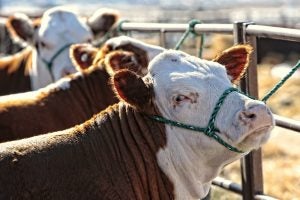
Shorthorn
These colorful cattle can come in a variety of acceptable colors: solid red, solid white with red hair or red pigment on ears, or any combination of red and white.
Motley face or brockle-faced calves risk being placed in another class, as well as black nose pigment, dilute color patterns, blacks, solid white claves, blue roans, grays, or brindles.
Brahman type
These “eared” cattle are typically easy to distinguish with characteristics that indicate a genetic makeup of the cattle subspecies Bos indicus: longer ear that is slightly pointed and droops opening down and forward, looser sheath, and prominent hump.
Any characteristics that indicate Bos taurus influence may disqualify your calf from this classification.
Many shows in Southeastern states and Texas have classes specific to Brahman type crosses that include Brangus, Santa Gertrudis, and Simbrah.
Continental and exotic type
Charolais
Large-boned, dilute-colored cattle will typically make the cut as Charolais if they’re white, yellow gray or silver expressing a dilute gene with minimal painting.
Things that could get you knocked out of a Charolais class might be red color, brindle, small bone, black color, or excessive painting.
Limousin
This classification will typically allow most colors (black, red, chocolate, and minimal brindle), and include bald and brockle face markings, the head shape will include a deeper eye socket, wide poll, and smaller, rounder ears.
Stocking legs, a spotted underline, roan color patterns and dilute genes will typically disqualify cattle from the Limousin classification.
Maine Anjou
Heavy-boned, solid red or black, red and white, or black and white calves might make the cut as Maine Anjou cattle. However, cattle that are brindle, roan, dilute, or appear to be over 50 percent crossbred will likely get the gate.
Classifying pigs at livestock shows
Berkshire
Berkshire classes will include black hogs with erect ears and six white points to include the nose, each leg, and sometimes the tail.
While a splash of white is sometimes appropriate on the body, a solid black or white face or excessive white may disqualify a hog from the Berkshire classification. Some other examples of discriminatory coloring may be: solid white ears and a belting pattern.
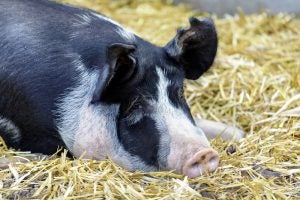
Chester White
In a Chester White class, you’ll see white-colored hogs with downward facing, medium-sized ears. These pigs cannot have any colored hair on their body or color on the skin larger than a U.S. minted silver dollar.
Duroc
The Durocs are an easy breed to spot. Except they won’t have spots. Red in color with downward-facing, medium-sized ears, they should not have black hair, shading, a belt, or spots. Some shows will allow spots smaller than two inches in diameter. These hogs must also not have an extra dew claw at many shows.
Hampshire
The Oreo of the pig world, Hampshire classification can get a little bit confusing at times. Ears on a Hampshire need to be erect and not rounded. Their white belt belt should start on a front leg, but can either partially or totally encircle the body at most shows. If the head is black and the body is white with freckling down the topline, this coloration is often acceptable.
But color patterns such as streaking on the forehead or red hairs may not be acceptable. Other color patterns that may knock a hog out of a Hampshire class would be white above the hocks (or tuber calis bone). These hogs typically should not have an extra dew claw.
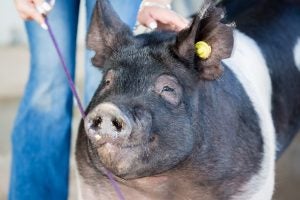
Hereford
Much like their cattle counterparts, the Hereford hot is red and white in color. Their ears are downward-facing and the underline of the animal can be red or white.
Pigs that have red on the head, ear, or legs may be at risk for a crossbred classification at some shows.
Landrace
These white-colored pigs have large, forward-slanting ears. Exhibitors should be careful to select hogs that show minimal pigmentation as any spot of skin larger than a U.S. minted quarter may disqualify a pig from this class. This breed of hog should also not have an extra dew claw.
Poland China
Poland China hogs have downward facing ears and are black and white in color with six white points: the face, feet, and tail unless docked. Pigs shown in this class should not have black legs or evidence of a belt. Red pigmentation of any kind will typically disqualify an animal from this class.
Spot
Spotted hogs have forward-facing or downward ears with black and white coloration. Hogs in this class should not have solid black from the ears forward, red tint, belted patterns, or brown spots.
Yorkshire
Yorkshires are a white breed of pig with erect ears. Similarly to other white classifications, any pigmented spots are discouraged with spots exceeding a U.S. minted silver dollar often calling for disqualification. These hogs must not have a dew claw.
Classifying sheep at livestock shows
Dorper sheep
While not every show will have a class for Dorper sheep, this classification allows for animals with Dorper characteristics: long, deep, wide-bodied sheep with well sprung ribs and muscling. Dorper sheep are haired instead of wool sheep with white bodies and black heads (except for White Dorpers).
Animals with wool characteristics will typically not qualify as a Dorper. Dark fiber on the body and solid-colored animals will typically not classify as Dorper sheep.
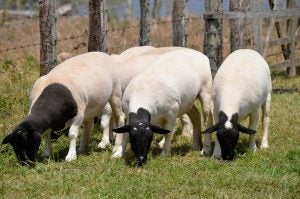
Finewool breeds
Dependent on your show, finewool breeds may be broken into specific classes, or simply classified as “finewools.” Breeds that fit this bill are typically Ramouillet, Delaine, Debouillet, or crosses between these breeds.
Finewool animals have silky, white faces with silky, medium-sized ears. Hooves are light-colored with minimal black streaking. Noses are typically neutral or pink in color.
Characteristics that might disqualify a lamb from the finewool class would be black eyelashes, excessive black streaking, brown or black spots in the skin and wool, coarse pelts, coarse hair on the face, excessive freckling or pigmentation.
Finewool cross
The finewool cross class is typically for crossbreeds that have at least 50 percent finewool breeding crossed with Hampshire or Suffolks. Animals in this class may have spotting or a brown face and ears with moderate spotting and brown legs. Wool is present below the hocks and knees on these animals.
Excessively black or dark brown color on the face may disqualify animals from this class. A lack of wool on rear legs, or black coloring may also ensure animals end up in another classification.
Southdown
Southdown sheep are an easy-to-recognize breed at livestock shows. With a lighter colored pigmentation, black hooves, chalk around the eyes and muzzle, animals in this class will have a broad head and muzzle with moderate ear length.
Speckled faces, ears, legs, white hooves, or pink pigmentation may disqualify animals from this class.
Medium wool
Medium wool classes will typically include Suffolk, Hampshire, and lambs that meet other class standards.
Remember, that no matter where you’re showing, it’s important to look up your show’s classification rules. And, at the end of the day, shows will often leave the final say to the livestock classifier or the livestock committee or chair for your species.
Heidi Crnkovic, is the Associate Editor for AGDAILY. She is a New Mexico native with deep-seated roots in the Southwest and a passion for all things agriculture.



